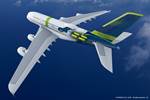Pratt & Whitney selected for hydrogen propulsion research project
The Hydrogen Steam Injected, Inter-Cooled Turbine Engine (HySIITE) project will use liquid hydrogen combustion and water vapor recovery to achieve zero in-flight CO2 emissions.

Photo Credit: Pratt & Whitney
The U.S. Department of Energy (DOE) announced it is allocating $175 million for 68 clean energy research and development (R&D) projects, including tasking Pratt & Whitney (East Hartford, Conn., U.S.) to develop novel, high-efficiency hydrogen-fueled propulsion technology for commercial aviation.
Under the Advanced Research Projects Agency – Energy (ARPA-E), the Hydrogen Steam Injected, Inter-Cooled Turbine Engine (HySIITE) project will use liquid hydrogen combustion and water vapor recovery to achieve zero in-flight CO2 emissions, while reducing nitrogen oxide (NOx) emissions by up to 80% and reducing fuel consumption by up to 35% for next-generation single-aisle aircraft.
“Pratt & Whitney has a long legacy with hydrogen-fueled propulsion, and we are excited to advance this emerging technology as part of our comprehensive strategy to support the aviation industry’s ambitious goal of achieving net zero aircraft CO2 emissions by 2050,” says Graham Webb Pratt & Whitney chief sustainability officer.
The HySIITE engine will burn hydrogen in a thermodynamic engine cycle that incorporates steam injection to dramatically reduce emissions of NOx, a greenhouse gas. The semi-closed system architecture planned for HySIITE will achieve thermal efficiency greater than fuel cells and reduce total operating costs when compared to using “drop-in” sustainable aviation fuels. This is the first direct collaboration between Pratt & Whitney and ARPA-E.
Related Content
-
Combining multifunctional thermoplastic composites, additive manufacturing for next-gen airframe structures
The DOMMINIO project combines AFP with 3D printed gyroid cores, embedded SHM sensors and smart materials for induction-driven disassembly of parts at end of life.
-
Composites manufacturing for general aviation aircraft
General aviation, certified and experimental, has increasingly embraced composites over the decades, a path further driven by leveraged innovation in materials and processes and the evolving AAM market.
-
A new era for ceramic matrix composites
CMC is expanding, with new fiber production in Europe, faster processes and higher temperature materials enabling applications for industry, hypersonics and New Space.













